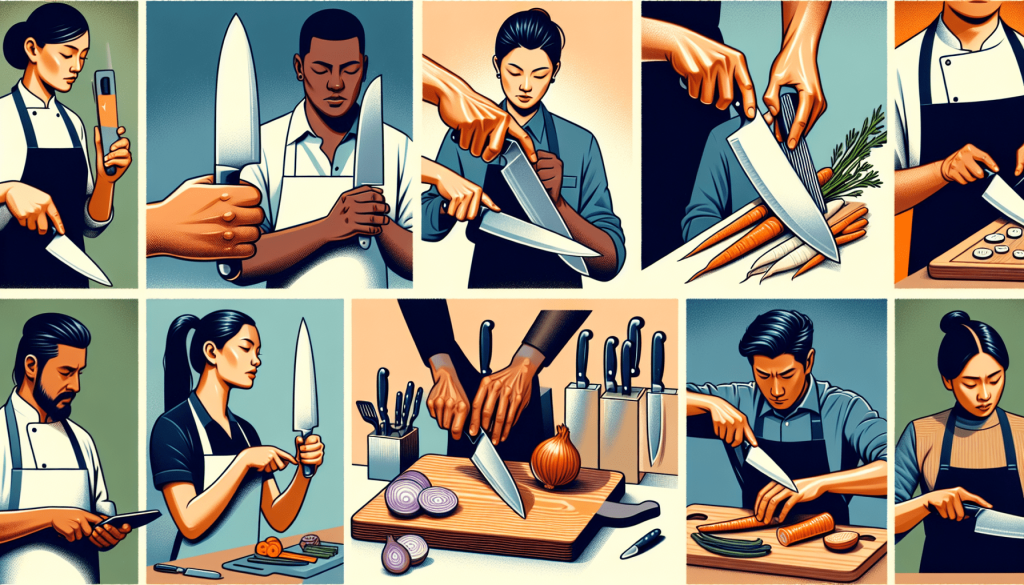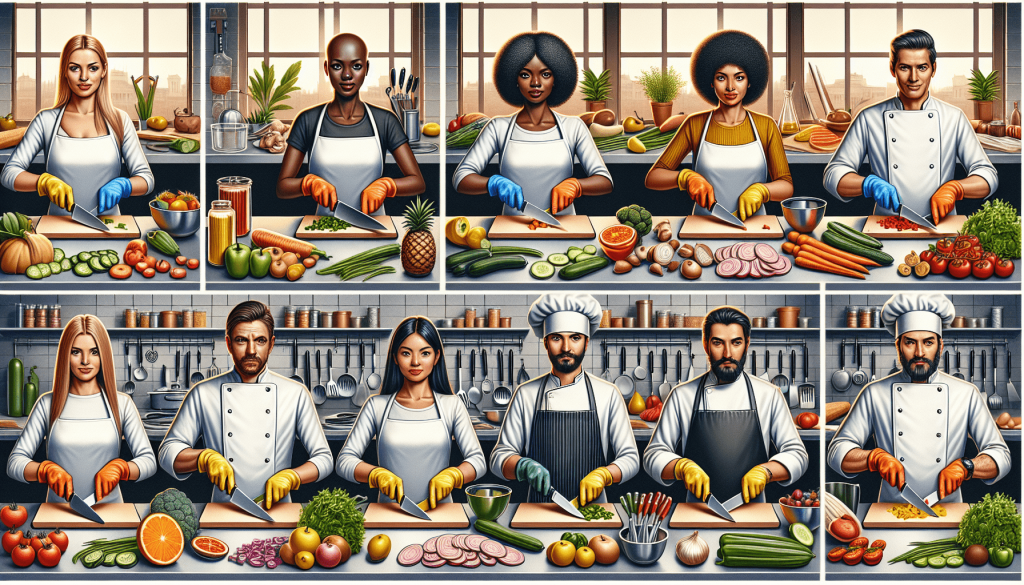You’ve always wanted to be that effortlessly skilled chef who impresses everyone in the kitchen with your knife skills. Whether you’re a beginner or just looking to sharpen your techniques, this article has got you covered. We’ll explore the fundamental knife skills that every home cook should know, from basic cuts to advanced techniques. By the end, you’ll feel confident wielding a knife like a pro, slicing and dicing with precision and finesse. Get ready to take your culinary game to new heights with this guide on how to master knife skills in the kitchen.
Choosing the right knife
When it comes to choosing the right knife, there are a few factors you need to consider. First and foremost, think about the type of knife you need. Are you looking for a versatile all-purpose knife, or do you need a knife specifically for a certain task? This will help narrow down your options and ensure that you choose a knife that suits your needs perfectly.
Another important factor to consider is the comfort of the handle. You’ll be using your knife for hours on end, so it’s crucial that the handle feels comfortable and secure in your hand. Look for knives with ergonomic handles that provide a good grip and reduce the risk of hand fatigue.
Sharpness is also a key consideration. A sharp blade not only makes cutting easier but also safer. Dull knives can cause slippage and unpredictable cuts, which can be dangerous. Before making a purchase, check the sharpness of the blade by gently running your finger along the edge. Be cautious when doing this, as even a slightly dull blade can still cause injury.
Lastly, investing in a good quality knife set is worth considering. While they may be more expensive upfront, high-quality knives will last longer and maintain their sharpness for a much longer time. This can save you money in the long run and ensure that you have reliable and efficient tools in your kitchen.
Understanding knife anatomy
To truly master knife skills, it’s important to have a good understanding of the anatomy of a knife. By familiarizing yourself with the different parts of a knife, you’ll be able to use the knife more effectively and efficiently.
The blade is the most important part of the knife. It’s the sharp, metal edge that does the cutting. The point of the blade is typically used for piercing and detail work, while the cutting edge is used for slicing, dicing, and chopping.
The spine of the blade refers to the back of the blade, opposite the cutting edge. It provides stability and strength to the knife. The tang is the portion of the blade that extends into the handle, and a full tang provides more balance and durability.
The bolster is the thick part of the knife between the blade and the handle. It adds weight and balance to the knife. The handle is where you grip the knife, and a comfortable handle is crucial for safe and efficient cutting.

Knife safety precautions
When handling a knife, safety should always be your top priority. By following a few simple safety precautions, you can significantly reduce the risk of accidents and injuries in the kitchen.
First and foremost, it’s important to hold the knife properly. Always grip the handle firmly with your fingers wrapped around it, maintaining a secure and stable grip. This will give you better control over the knife and reduce the risk of slippage.
Another critical safety precaution is to keep your fingers away from the blade. Many accidents occur when fingers get too close to the cutting edge. To prevent this, curl your fingers under and use your knuckles to guide the knife while keeping your fingertips tucked away.
Using a cutting board with a non-slip surface is essential for preventing accidents. The board should be stable and secure, ensuring that it doesn’t move or slide while you’re using the knife. This will provide a stable surface for chopping and reduce the risk of the knife slipping and cutting in an unintended direction.
Lastly, avoid distractions while using a knife. It’s easy to get caught up in conversations or watching TV while cooking, but this can lead to accidents. Always stay focused on the task at hand and give your full attention to the knife and cutting process.
Basic knife skills
Once you have chosen the right knife and understand the basic safety precautions, it’s time to master the fundamental knife skills. These skills will form the foundation for all your cutting techniques and help you become more efficient in the kitchen.
Start by mastering the basic grip and stance. Hold the knife with your dominant hand, gripping the handle firmly. Your thumb and forefinger should be placed on opposite sides of the blade, while your other fingers wrap around the handle. Stand with your feet shoulder-width apart and maintain a comfortable and stable posture.
Practice the rocking motion for efficient chopping. Place the tip of the knife on the cutting board and use a gentle rocking motion to slice through the ingredients. This technique allows you to chop quickly and efficiently while maintaining control over the knife.
Learn different cutting techniques such as slicing, dicing, and mincing. Each technique requires a slightly different hand and blade motion, so spend time practicing each one individually. As you become more comfortable, you can start incorporating these techniques into your cooking routine.
Work on your knife speed and accuracy. With practice, you’ll be able to increase your speed without compromising on precision. Remember, it’s more important to be accurate and safe than to rush through a cut and risk injury.

Knife maintenance and care
To ensure your knives remain in optimal condition, proper maintenance and care are crucial. By following a few simple steps, you can extend the life of your knives and maintain their sharpness.
Clean your knife after each use. Use warm, soapy water and a non-abrasive sponge to clean off any food debris. Dry the knife thoroughly to prevent any water spots or rust from forming.
Store your knives properly to prevent damage. Avoid throwing them in a drawer where they can bang against other utensils. Instead, opt for a knife block or magnetic strip to keep them safely organized and protected.
Sharpen and hone the blade regularly. Over time, the blade will naturally become dull, so it’s important to maintain its sharpness. Invest in a good quality knife sharpener or a sharpening stone and follow the instructions carefully.
Consider professional knife sharpening services. If you’re not confident in sharpening your knives yourself, seek out professional services. They have the expertise and tools to sharpen your knives effectively, ensuring that they perform optimally.
Knife selection for specific tasks
Different knives serve different purposes, so it’s important to have a variety of knives in your kitchen to tackle any task effectively.
A chef’s knife is a versatile all-purpose knife and a must-have in any kitchen. Its broad blade and curved edge allow for a range of cutting techniques, from slicing vegetables to chopping herbs. This is the go-to knife for most everyday cooking tasks.
For intricate tasks such as peeling, coring, and trimming, a paring knife is essential. Its small size and precise blade allow for detailed work on fruits, vegetables, and other delicate ingredients.
When it comes to slicing bread, a serrated knife is your best friend. The serrated edge allows for clean, effortless cuts without crushing the bread.
If you frequently work with meat, a boning knife is a valuable addition to your knife set. With its narrow, flexible blade, it’s perfect for removing bones, skin, and other tough connective tissue.
Advanced knife skills
Once you have mastered the basic knife skills, you can start exploring more advanced techniques to take your culinary skills to the next level.
Master the technique of julienne and batonnet. These are precise, uniform cuts that are commonly used in French cuisine. Julienne involves cutting ingredients into thin, matchstick-like strips, while batonnet is slightly thicker, resembling small sticks.
Practice filleting and deboning fish. This technique requires precision and a steady hand. With practice, you’ll be able to remove the bones and achieve clean fillets.
Learn to carve a roast or turkey. This skill is especially handy during festive seasons or family gatherings. Proper carving ensures that each slice is even and presentable.
Explore decorative knife cuts. This involves creating decorative shapes out of fruits and vegetables, adding an artistic touch to your dishes. From flower-shaped carrots to intricate citrus garnishes, decorative knife cuts can elevate the presentation of your meals.
Efficient food preparation
Improving your knife skills not only makes you a more efficient chef but also helps you reduce waste and achieve consistent results.
Learn to prepare ingredients efficiently. This means selecting the right knife for the task and understanding the most effective technique for cutting a particular ingredient. With practice, you’ll be able to peel, chop, and slice ingredients in a fraction of the time.
Use proper cutting techniques to reduce waste. A sharp knife and proper technique will minimize the amount of food discarded during the cutting process. Additionally, learning to work close to the root or stem of an ingredient will help you get the most out of it.
Create uniform cuts for even cooking. Consistent cuts ensure that the ingredients cook evenly, resulting in a perfectly cooked dish. Practice making slices of the same thickness to achieve balanced results.
Tips for improving knife skills
Improving your knife skills requires practice and dedication. Here are a few tips to help you on your journey to becoming a master in the kitchen:
Practice regularly to build muscle memory. The more you use your knife, the more comfortable and skilled you’ll become. Set aside time each week to practice different cuts and techniques to build the necessary muscle memory.
Watch videos or attend cooking classes for guidance. There are plenty of online tutorials and cooking classes available that can provide valuable guidance on knife skills. Visual demonstrations can help you better understand the techniques and correct any errors you may be making.
Challenge yourself with new recipes and techniques. Cooking is a continuous learning process, so don’t be afraid to try new recipes that require different cutting techniques. This will keep you engaged and motivated to improve your knife skills.
Stay patient and focused on safety. Knife skills take time to develop, so don’t get discouraged if you don’t see immediate progress. Stay patient and always prioritize safety to avoid accidents and injuries.
Common mistakes to avoid
Even with the best intentions, it’s easy to make mistakes when it comes to knife skills. Here are some common mistakes to avoid:
Using a dull knife. A dull knife requires more force to cut, increasing the risk of accidents. Always make sure to keep your knives sharpened to maintain their effectiveness and safety.
Applying too much pressure while cutting. Let the sharpness of the knife do the work. Applying excessive force not only increases the risk of slips but also affects the precision of your cuts.
Neglecting proper hand positioning. Keeping your fingers too close to the blade is a recipe for disaster. Always ensure that your fingers are properly curled under and away from the cutting edge.
Not using the right knife for the task. Each knife has a specific purpose, and using the wrong knife can make cutting more difficult and dangerous. Take the time to familiarize yourself with the different types of knives and their intended uses to avoid unnecessary risks.
By following these guidelines and practicing regularly, you can master knife skills that will greatly enhance your culinary abilities. So grab your knife, be mindful of safety, and let your newfound skills transform your cooking experience. Happy chopping!
